| itinerary < 5 April Hilo, Big Island Merrie Monarch Modern Hula > | Merrie Monarch 5 April 2013 |
Kahiko: traditional hulaI wrote about the opening ceremonies -- like any other American event, the national anthems. Yes, both of them. Again, the difference is startling, and maybe ominous. The very mixed audience -- racially and socially mixed as is only possible in Hilo -- stands respectfully for the Star Strangled Bannaner, ably sung, with the usually vocal flourishes that would fit better on American Idol. Then, the adorable little crumpet begins, "Hawai'i pono i..." and the house lights up. I think I have never heard so big a group sing together so beautifully, and with so much ... well, there's only one word that works: with so much aloha. But I digress. There was dancing. 29 groups. (We made it through 25.) Men dance. For anyone who's seen Maori dancing, no more needs to be said. The men's dancing contains all the strength and aggression of tribal dancing by male warriors in their prime, who dance to declare territory, to build character and teamwork, to keep in shape, and to have fun. It's heart-thumpingly awesome. |
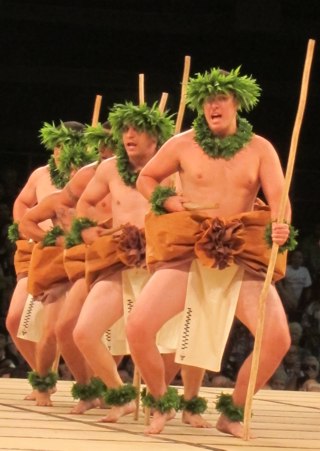 |
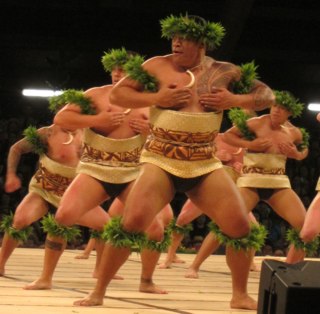 |
Look at this bruiser. Know that in real life he is, by tradition, breeding, and constitution, one of the gentlest, sweetest spirits on the planet. I think the message implicit in the dance, however, is, "don't mess with dese guys." And these guys dance with grace, athleticism, and foot-stomping power. The girls in the audience scream with delight. |
|
Each group is coordinated by a chanter or group of chanters, usually playing ipu, a drum-gourd -- the gourds are grown especially to the purpose, and are shaped, polished, and decorated. They are played by thumping them on mats on the floor, slapping them on their sides. Often, as here (at right) the is the head chanter, and is often led on and off the stage with great ceremony. Where there is synthetic respect for the King and Queen of hula, the screaming of the audience when a beloved kumu is first sighted is deafening and at first unsettling. The progress on and off the stage by each group is carefully presented -- this is, after all, a competition, and the 29 groups competing care very much about who wins. |
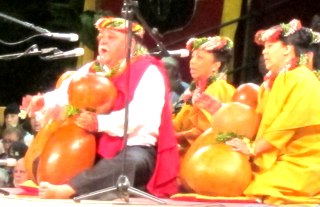 kumu and back-up singers with ipu |
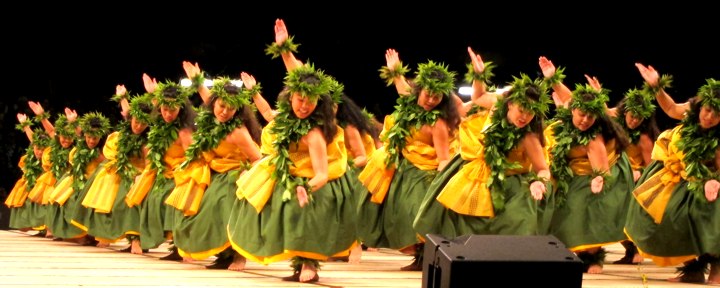 |
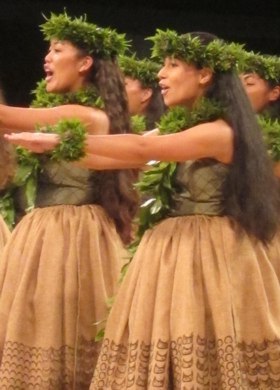 |
The men's dancing is undoubtedly what made the 1890s missionaries sleep poorly ...until they outlawed the language and the dance. The tradition of men's dancing was pushed underground for decades, but women's dancing was resurected (for the tourists) fairly soon. The traditional form of women's dancing remains bawdlerized in dress and motion. Where the men bump and grind (and the audience screams) the women wear pantaloons underneath their skirts in order to keep their modesty. Never understood by the usurpers, Hawaiian tradition is closely tied to the land, and a resolute sense of how it must be cared for. Pre-contact Hawaii was densely populated, with thousands living in areas that today support no one, and hundreds of thousands -- no one knows for sure, and the testimony of the artifacts and archaeology is hard to believe -- living on Hawaii, Maui, Oahu, and Kauai. In the dance, this appears in the head, wrist, and ankle ornaments, lovingly fashioned of real plants that are grown and harvested with a long view of their future needs. The Islanders plan to dance on forever. On the mainland we encounter the phrase "Live Aloha" (and would be wise to do so) but here, especially among the dancers, it's easy to see that dancing is their life. Halau after , groups of 35 beautifully prepared women take the stage, all shapes and sizes (but young -- this is a young person's sport) with waist length hair, bright eyes, and unbelievable passion and focus. |
 |
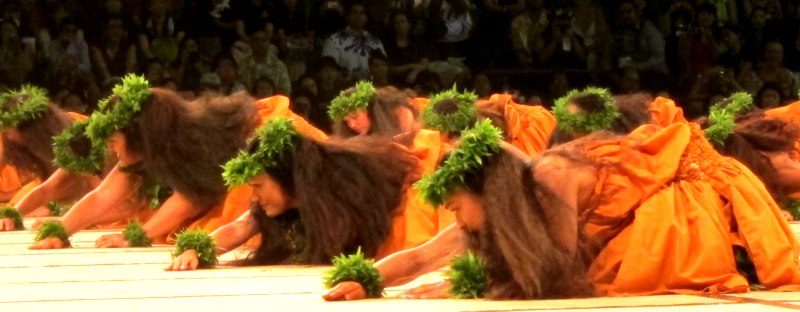 |
|
A word about the audience: sweet. Another word might be "fanatical." They -- we -- are gathered to honor and preserve a tradition that we clearly believe imparts heightened meaning to life and our inter-relationship with other peoples and species. This audience is kind, friendly, quick to take care and watch out for each other. There are no strangers here. Hawaii's unique experiments with lowering the barriers between races and social casts is fascinating, and apparently successful. It is never forgotten that there are , , and the great us. The conchs are blown to clear the way, so no commoner's foot falls on a lord's shadow. But miraculously this turns out to be a way to level the differences.
|
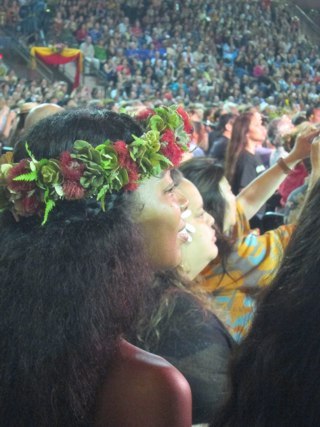 |
 |
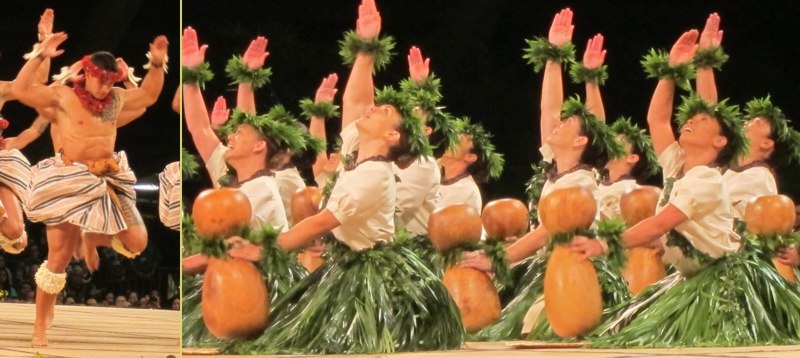 |
 |
updated 16 June 2023 Caspar Time site software and photographs by the Caspar Institute except as noted this site generated with 100% recycled electrons! send website feedback to the CI webster © copyright 2002-2024 Caspar Institute |